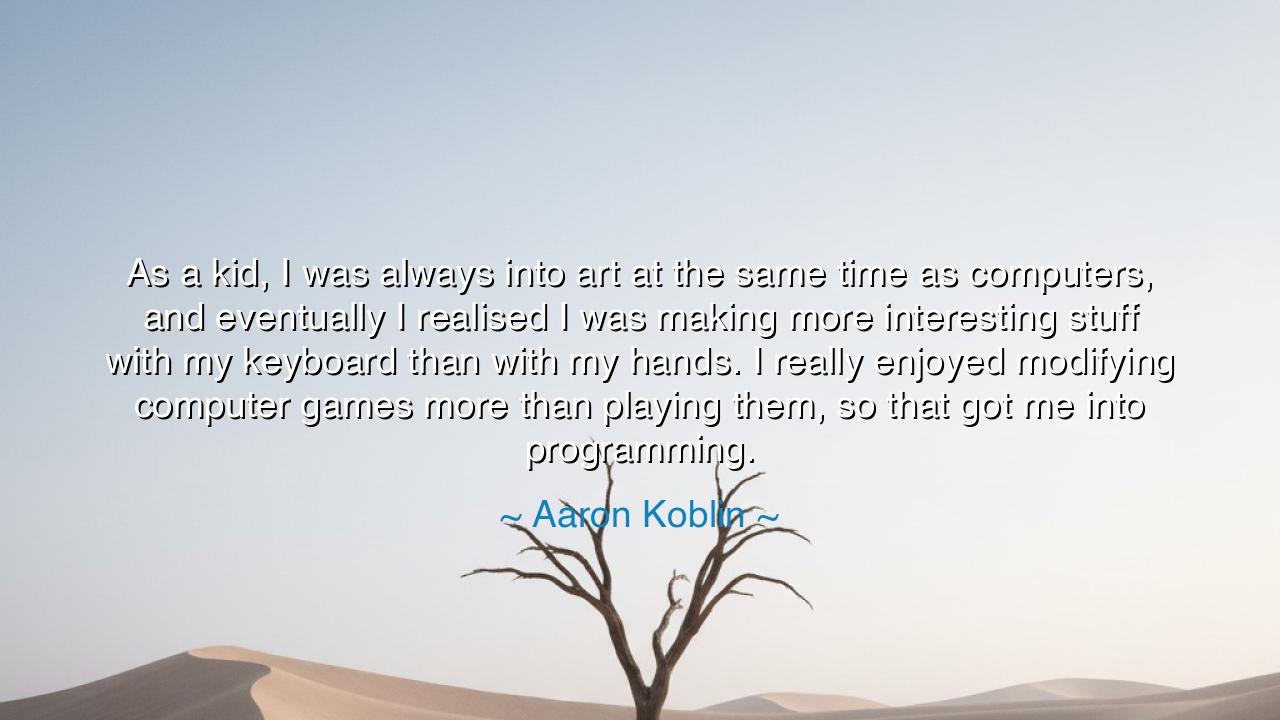
As a kid, I was always into art at the same time as computers
As a kid, I was always into art at the same time as computers, and eventually I realised I was making more interesting stuff with my keyboard than with my hands. I really enjoyed modifying computer games more than playing them, so that got me into programming.






“As a kid, I was always into art at the same time as computers, and eventually I realised I was making more interesting stuff with my keyboard than with my hands. I really enjoyed modifying computer games more than playing them, so that got me into programming.” — in these words, Aaron Koblin, the digital artist and visionary of the twenty-first century, describes the birth of a modern alchemy: the fusion of art and technology, of imagination and computation. His reflection is more than a personal memory — it is the story of an age, the moment when human creativity first learned to speak in the language of machines. Beneath his humility lies a truth of profound depth: that the boundary between the artist and the engineer, between creation and construction, is but an illusion of habit.
Koblin’s words emerge from the dawn of the digital renaissance, a time when brushes were replaced by pixels and canvases by code. He speaks of a child’s wonder — that sacred energy of curiosity that sees no separation between drawing and programming, between the play of color and the play of logic. For him, the keyboard became not a tool of limitation but a new kind of brush — one that could conjure worlds from mathematics and motion. In this transformation, we glimpse the eternal human urge to reshape reality through creativity, no matter the medium.
In ancient times, the artist carved from marble or painted with pigment; in Koblin’s age, he sculpts from data and paints with algorithms. Yet the spirit is the same — to take what is abstract and invisible and give it form. Koblin, known for works that use massive data sets and collaborative visualization, found joy not in playing the world created by others, but in building new worlds of his own. His delight in “modifying computer games” reflects the essence of creation itself: to go beyond consumption into contribution, to change what is given and make it one’s own. In this, he echoes the ancient craftsmen who improved their tools, the inventors who altered the instruments of their trade, transforming work into art through mastery.
History offers us a mirror to his journey. In the Renaissance, Leonardo da Vinci stood between the same two worlds — the artistic and the scientific. He drew machines as beautifully as he painted faces, and in both he saw the divine harmony of structure and soul. Koblin’s digital art continues this lineage, proving that creativity is not bound to medium or material, but to vision. Just as Leonardo blended pigment and geometry to study the flight of birds, so does Koblin blend code and emotion to study the flight of human imagination.
There is also humility in his realization — that he made “more interesting stuff with my keyboard than with my hands.” This is not a rejection of tradition, but an evolution of it. He recognizes that tools change, but the act of creation remains eternal. Just as the chisel once replaced the bare hand, and the camera once replaced the brush, so too does the computer become the modern instrument of art. Yet, as Koblin’s career shows, it is not the tool that defines the art — it is the imagination that commands it. The power of his discovery lies not in technology itself, but in his choice to use it for expression rather than escape.
In his words, there is also a hidden teaching about the nature of curiosity and mastery. To play is to participate, but to modify is to understand. The moment he shifted from player to creator, from user to maker, he crossed the threshold that separates imitation from innovation. This is the moment that every great mind experiences — when fascination becomes purpose, and curiosity becomes craft. Whether in programming, writing, or sculpting, it is the same awakening: the realization that the joy of life lies not in merely experiencing the world, but in shaping it.
The lesson, then, is timeless and clear: embrace the tools of your age, but let your imagination lead them. Do not separate art from science, nor beauty from logic. Creation is not confined to paint or stone — it lives wherever the human spirit transforms thought into form. Like Aaron Koblin, seek not only to consume the games of others, but to rewrite them; not only to play within worlds, but to build new ones. For the greatest artistry of all is the courage to innovate — to stand at the intersection of heart and machine, and to make something that has never been made before.
So remember, O creator of tomorrow — your hands and your keyboard are both extensions of the same soul. Whether through brush or code, your task is the same as it was for the ancients: to bring order to chaos, beauty to the unseen, and meaning to the infinite. As Aaron Koblin teaches, art and technology are not rivals but partners, and when they unite under the guidance of wonder, they become the wings by which the human spirit continues its eternal ascent.






AAdministratorAdministrator
Welcome, honored guests. Please leave a comment, we will respond soon